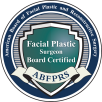ABOUT YOUR VISIT
NEW PATIENT?
About Your Visit
New Patient Information: We look forward to meeting you on your initial visit to our offices. At this time, we’ll help you get acquainted with our services and learn about your particular diagnostic and treatment needs. Our completely electronic medical record allows us to provide you with the highest quality care and allows for optimal communication with your other health care providers. In addition, we know that every patient is different and has specific needs, and we will strive to provide you with personal, individualized attention.
Payments We Accept

Cancellations
We strive to provide expeditious care when necessary. Please notify us at least 72 hours in advance for any cancellation as this will allow us to give your appointment slot to another patient. Thank you.
Post Procedure Instructions
FAQs
Frequently asked questions
The ideal age varies depending on the procedure. Some surgeries, like rhinoplasty, are often performed in late teens or early twenties, while others are more common among older adults seeking anti-aging treatments.
When performed by a board-certified plastic surgeon in a accredited facility, plastic surgery is generally safe. However, all surgical procedures carry inherent risks, and individual factors also play a role in safety.
Recovery time varies depending on the procedure and individual healing abilities. Some treatments may have minimal downtime, while others may require several weeks of recuperation.
Skilled surgeons strive to provide natural-looking outcomes. Open communication with your surgeon about your expectations and goals is crucial for achieving the results you desire.
Most surgeries result in some scarring, but plastic surgeons aim to minimize scarring through careful incision placement and suturing techniques. Scar management post-surgery can also help.
The cost varies by procedure and location. We do not accept insurance.
It's crucial to select a board-certified plastic surgeon with extensive experience in the specific procedure you're interested in. Reading reviews, checking credentials, and scheduling consultations can help with this decision.
Risks include infection, scarring, anesthesia complications, and dissatisfaction with results. An open discussion with your surgeon about potential risks and how they can be minimized is essential.




